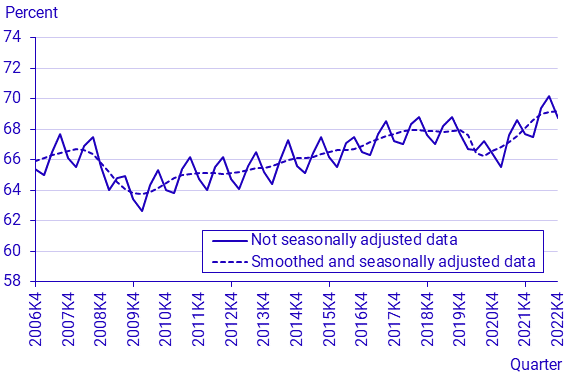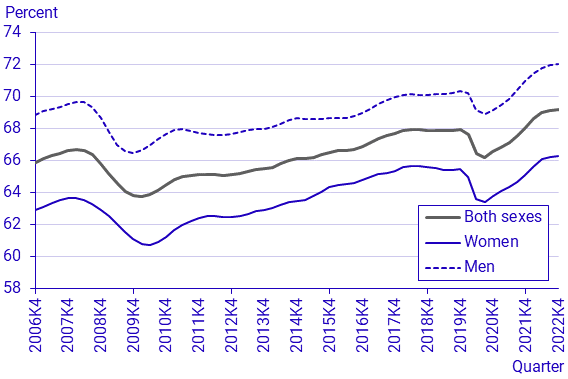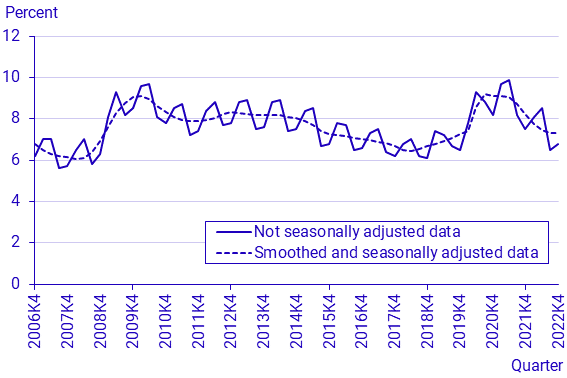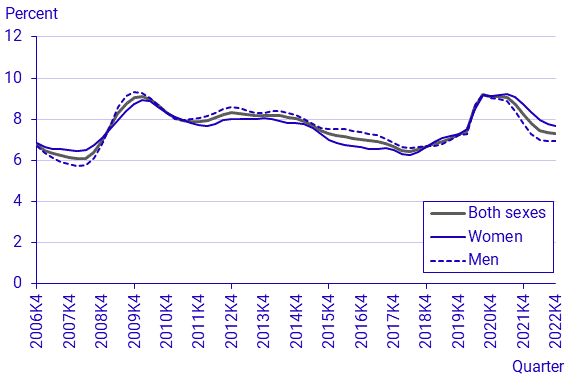Labour Force Surveys (LFS), fourth quarter 2022
Hours worked increased in the fourth quarter
Statistical news from Statistics Sweden 2023-02-07 8.00
In the fourth quarter of 2022, there were 5 194 000 employed persons, not seasonally adjusted. This is an increase of 110 000 persons compared to the fourth quarter of 2021. The average number of hours worked per week amounted to 164.8 million hours. In calendar-adjusted figures, this corresponds to an increase of 3.0 percent. The unemployment rate was 6.8 percent, a decrease of 0.7 percentage points. Seasonally adjusted and smoothed data indicates an increase in the number of employed. The seasonally and smoothed unemployment rate was 7.3 percent.
– The number of employed and hours worked continued to increase during the fourth quarter, although at a slightly lower rate than in previous quarters. It indicates a slowdown in the labour market, says Mikael Lundsten, statistician at the Labour Force Surveys at Statistics Sweden.
The labour force
The number of persons in the labour force aged 15-74 years was 5 573 000 in the fourth quarter of 2022, not seasonally adjusted, an increase with 79 000. The number of women in the labour force amounted to 2 628 000, an increase with 35 000, and the number of men to 2 945 000, an increase with 44 000. The relative labour force participation rate increased by 0.7 percentage points and amounted to 73.8 percent. Among women it was 70.8 percent and among men it was 76.6 percent.
Seasonally adjusted and smoothed data shows an increase in the number of persons in the labour force compared with adjacent quarters. There were 5 639 000 persons in the labour force, which corresponds to 74.6 percent of the population.
Employment
In the fourth quarter of 2022, there were 5 194 000 persons aged 15–74 in employment, not seasonally adjusted, which is an increase of 110 000 compared to the corresponding quarter a year ago. This corresponds to an employment rate of 68.7 percent, an increase of 1.0 percentage points. The number of employed people increased by 55 000 among both women and men. There were 2 440 000 employed women and 2 754 000 men. Among women, the employment rate was 65.7 and among men 71.7 percent. There was an increase among both women and men compared to the fourth quarter of 2021, by 1.1 and 1.0 percentage points respectively. There were 499 000 young people aged 15–24 years in employment, an increase of 49 000. The employment rate for people aged 15-24 was 42.4 percent, an increase of 3.2 percentage points.
Seasonally adjusted and smoothed data indicates an increase in the number of employed persons compared with adjacent quarters. In the fourth quarter of 2022, there were 5 228 000 employed persons, which corresponds to an employment rate of 69.2 percent.
Employees
In the fourth quarter of 2022, there were 4 680 000 employees, not seasonally adjusted, which is an increase of 113 000 compared to the corresponding quarter of the previous year. Among those, 2 297 000 were women, an increase of 50 000, and 2 383 000 were men, an increase of 63 000. There were 3 980 000 permanent employees, an increase of 73 000. Among permanent employees, the number of women increased by 37 000 to 1 914 000 and the number of men was 2 066 000. There were 700 000 temporary employees. Among them 382 000 were women and 318 000 men.
Compared with adjacent quarters, seasonally adjusted and smoothed data shows an increase in the number of employees and in permanent employees, and a decrease in temporary employees. According to seasonally adjusted and smoothed data, the number of employees was 4 713 000. The corresponding figure for permanent employees was 3 978 000 and for temporary employees 735 000.
Hours worked
The average number of hours worked per week in the fourth quarter of 2022 amounted to 164.8 million hours, not seasonally adjusted. In calendar-adjusted figures, this corresponds to an increase of 3.0 percent compared with the fourth quarter of 2021. Seasonally adjusted and smoothed data indicates an increase in the average number of hours worked per week compared to adjacent quarters. The number of hours worked averaged to 157.5 million per week.
The majority of employed persons have an agreed working time of 35 hours or more per week, that is, full-time work. Agreed working time in 2021 and 2022 excludes secondary jobs. In the fourth quarter of 2022, 4 032 000 persons worked full time, which is an increase of 98 000 persons compared to the fourth quarter of 2021. Among them 1 738 000 were women, an increase of 52 000, and the number of men increased by 47 000 to 2 294 000. In total, 267 000 persons worked short part-time (1–19 hours), an increase by 35 000 and 602 000 persons worked long part-time (20-34 hours).
The average actual hours worked among employed persons aged 15–74 years increased by 0.7 hours and amounted to 31.7 hours per week in the fourth quarter of 2022. Women worked 29.3 hours per week and men worked 33.8 hours per week, an increase by 0.8.
Underemployment
Among employed persons aged 15–74, 316 000 were underemployed in the fourth quarter of 2022. Among them, 146 000 were women and 170 000 were men, an increase with 23 000. Underemployed persons accounted for 6.1 percent of employed persons.
Unemployment
In the fourth quarter of 2022, there were 379 000 unemployed persons aged 15-74, not seasonally adjusted, which is a decrease of 31 000 persons compared to the fourth quarter of 2021. This corresponds to an unemployment rate of 6.8 percent, a decrease of 0.7 percentage points. There were 188 000 unemployed women and 191 000 unemployed men. The unemployment rate for women decreased by 0.9 percentage points to 7.1 percent, and the male unemployment rate were 6.5 percent.
For persons aged 15–74, seasonally adjusted and smoothed data for the number of unemployed amounted to 411 000 in the fourth quarter, which corresponds to an unemployment rate of 7.3 percent.
There were 132 000 long-term unemployed persons (unemployed for at least 27 weeks) aged 15–74 years in the fourth quarter of 2022, a decrease of 25 000 compared to the fourth quarter of 2021. Among long-term unemployed persons, 61 000 were women, a decrease of 18 000, and 72 000 were men.
There were 123 000 unemployed young persons aged 15–24, not seasonally adjusted. This corresponds to an unemployment rate of 19.7 percent.
Among young persons aged 15–24, seasonally adjusted and smoothed data shows an increase in the number and share of unemployed persons compared with adjacent quarters. The number of unemployed young persons amounted to 147 000, corresponding to an unemployment rate of 21.7 percent.
Not in the labour force
The group 'not in the labour force' includes persons who are not classified as employed nor as unemployed. In the fourth quarter of 2022, there were 1 982 000 persons not in the labour force. Among them, 1 085 000 were women and 897 000 were men.
Among persons not in the labour force, there were 865 000 retired persons, 652 000 full-time students and 286 000 persons who reported that they were on long-term sick leave.
Latent job seekers
There were 254 000 latent job seekers aged 15–74 years in the fourth quarter of 2022. Among young people aged 15–24, the number of latent job seekers decreased by 17 000 to 122 000.
Unused labour supply
Unemployed persons, underemployed persons and latent job seekers together comprise the unused labour supply. In the fourth quarter of 2022, the unused labour supply averaged 20.0 million hours per week. The unused labour supply corresponds to 500 000 full-time employments with 40-hour work weeks.
Labour market for persons aged 20-64 years
The population presented by the LFS is comprised of persons aged 15–74 years. However, labour market participation among younger and older in this age group is considerably lower for natural reasons, as this group contains large shares of students and retired persons. To better approach what can be seen as the core of the actively working population, the situation of the age group 20–64 years is described in the following section.
The relative labour force participation rate among persons aged 20–64 years amounted to 87.1 percent in the fourth quarter of 2022, not seasonally adjusted. For women, the relative workforce participation rate was 83.9 percent, and for men it was 90.2 percent. Seasonally adjusted and smoothed data shows that the labour force participation rate amounted to 87.7 percent.
In the fourth quarter of 2022, the share of employed persons aged 20–64 was 82.0 percent, not seasonally adjusted, an increase of 0.8 percentage points compared to the fourth quarter 2021. For women, the corresponding figure was 78.8 and for men 85.0 percent. Seasonally adjusted and smoothed data shows that the employment rate were 82.3 percent.
According to not seasonally adjusted data, the unemployment rate in the age group 20–64 amounted to 5.9 percent, a decrease of 0.7 percentage points compared to the fourth quarter of 2021. The unemployment rate for women was 6.1 and for men 5.7 percent. Seasonally adjusted and smoothed data shows an unemployment rate of 6.2 percent.
Swedish born and foreign born persons aged 20–64 years
The relative labour force participation rate among Swedish born persons aged 20–64 years was 87.9 percent in the fourth quarter of 2022, not seasonally adjusted. Among Swedish born women, the relative participation rate amounted to 85.9 percent, and among Swedish born men it was 89.8 percent. Among foreign born persons aged 20–64 years, the relative participation rate was 85.0 percent. The corresponding figure was 78.8 percent among foreign born women, and 91.4 percent among foreign born men, an increase with 2.4 percentage points. Compared with adjacent quarters, seasonally adjusted and smoothed data shows an increase in the labour force participation rate for foreign born persons. The labour force participation rate amounted to 88.5 percent among Swedish born persons, and it was 85.5 among foreign born persons.
In the fourth quarter of 2022, the share of employed Swedish born persons aged 20–64 was 85.2 percent, not seasonally adjusted. Among Swedish born women, the employment rate was 83.3 percent and among Swedish born men the employment rate was 87.0 percent. Among foreign born persons, the employment rate was 72.9 percent, an increase of 2.7 percentage points. The employment rate for foreign born women was 66.9 percent, an increase of 3.0 percentage points. For foreign born men it increased by 2.7 percentage points to 79.1 percent. Seasonally adjusted and smoothed data shows an increase in the employment rate compared to adjacent quarters for foreign born persons. The employment rate was 85.6 percent among Swedish born and 73.1 percent among foreign born persons.
The relative unemployment rate among Swedish born persons aged 20–64 years was 3.0 percent in the fourth quarter of 2022, a decrease of 0.4 percentage points compared to the fourth quarter of 2021. Among both Swedish born women and men, the unemployment rate were 3.0 percent. An decrease by 0.7 percentage points for Swedish born men. The unemployment rate among foreign born persons was 14.2 percentage points, down by 2.0 percentage points. For foreign born women it was 15.0 percent, a decrease by 3.4 percentage points. For foreign born men it was 13.5 percent. Seasonally adjusted and smoothed, the unemployment rate amounted to 3.2 percent for the Swedish born and 14.6 for the foreign born, a decrease compared to the previous quarter.




Definitions and explanations
Since the LFS is a sample survey, the results are subject to some uncertainty. The LFS basic tables contain uncertainty figures and refer to non-seasonally adjusted data.
Seasonally adjusted and smoothed data (trend values): data in which normal seasonal variations have been removed, then smoothed to reduce sampling error and short-term variations. Seasonally adjusted and smoothed data may be revised following new monthly outcomes and usually does not coincide with non-seasonally adjusted data. Seasonally adjusted and smoothed data is not to be compared with non-seasonally adjusted data.
More detailed results are available in the form of figures and tables on employed persons, hours worked, unemployed persons and more, on Statistics Sweden’s website.
Next publishing will be
2023-02-17, at 08:00.
Feel free to use the facts from this statistical news but remember to state Source: Statistics Sweden.
